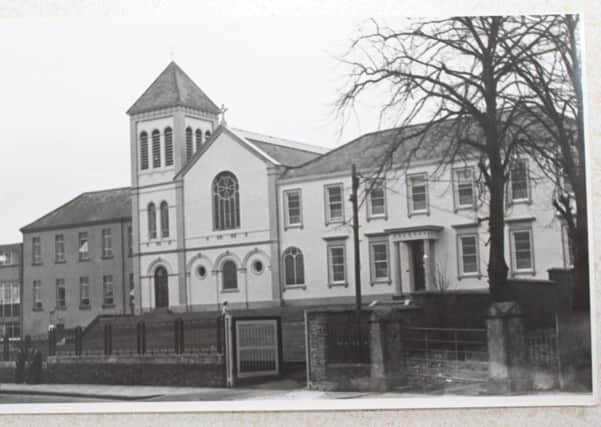Convent of Mercy celebrating 150 years of teaching and helping


The Mercy nuns have been at the cutting edge of education for both boys and girls in Lurgan for all this time - trailblazers, paving the way for a modern, well-taught society.
As a mark of Thanksgiving for their service throughout decades, a special Mass will be held in St Peter’s Church this Saturday.
Advertisement
Hide AdAdvertisement
Hide AdWith Chief Celebrant Bishop John McAreavey, the people of Lurgan are expected to unite in gratitude for the work these nuns have carried out over the past 150 years.


The Thanksgiving Mass will be held on Saturday, August 20th, at 6pm.
Everyone is most welcome to refreshments in the Parish Hall where you will have an opportunity to mingle and speak with the Sisters.
Sr. Evelyn Kenny will give a summary of the work done by sisters since their Foundation in 1866.
Advertisement
Hide AdAdvertisement
Hide AdIt is a remarkable history and dates from 1865. Then, acting on behalf of the Very Reverend James McKenna, a member of the Magee family of Union Street bought a piece of waste ground close to the livestock pound in Edward Street.


It was the site for a Convent and was bought in February of 1865, Building work started in March 1865 and in May 1866 it was completed and ready for a number of nuns who arrived in Lurgan from Newry along with Mother Emmanuel Russell.
On the 10th September 1866, the nuns opened two schools inside the building, for girls, St Mary‘s, for boys, St, Joseph‘s. The two schools were free, but if the family could pay, it was one penny a week.
They also opened night classes for adults, mainly for those wishing to learn to read and write.
Advertisement
Hide AdAdvertisement
Hide AdNumbers for the day schools averaged at 280 pupils and 190 for night school.
Before this, the only Catholic girls school in the area was in a wooden shed in the Dougher cemetery.
It was difficult to get the board of education in Dublin to recognise these new schools, so obtaining equipment was difficult. Nuns often made alphabet cards out of letters from newspaper headlines.
Older girls were allowed to bring cradles to school so they could take care of the younger members of their family instead of remaining at home to do so.
Advertisement
Hide AdAdvertisement
Hide AdLurgan in those days was a power house for the linen industry. There was scarcely a house where there was not a loom. People worked 12 hour days and paid between six and nine pence a day.
Most Catholics were very poor and there was no compulsory education for children until 1921. Child labour was permitted and little boys and girls were sent to work as soon as they were able, aged at eight or nine years old.
Also soon after they arrived, the nuns saw the need for an orphanage in the town and two outbuildings were converted into a neat home for orphans and opened in 1866. This house proved to be too small due to the numbers of applicants so a larger house was secured for them in Church Place in 1877 and became known as the Orphanage of the Immaculate Conception. It closed in 1880 due to difficulties with running costs.
In 1871, Lurgan became an independent foundation with Sister Mary Gertrude O’Hagan as the first Mother Superior of The Convent of Mercy. Well established by 1875, the community began a school building programme. The Edward Street school cost of £1,000 to build.
Advertisement
Hide AdAdvertisement
Hide AdA Girls’ Industrial School was established in 1888 for 50 pupils. The building and property known as ‘Irishtown Hill House’ at Cornakinnegar was bought for a Boys Industrial School in 1892. The school was named St Michael’s.
After the partition of Ireland in 1922 circumstances changed and the number of children declined. Both schools were closed in 1924.
However, St Michael’s Industrial School reopened as a boarding school for girls in 1924. In 1947 the school became Our Lady’s Grammar School for 25 years and with the introduction of the Dickson Plan in the late 60s the school became St Michael’s Grammar School.
In 1969 Fr Christopher Murray asked for sisters to give religious instruction to Catholic children attending Tullygally Primary School which was non-Catholic as a Catholic school was not ready. Later he asked that sisters be sent to form a community in Craigavon and in November 1976 a new branch house was formed in Craigavon.
Advertisement
Hide AdAdvertisement
Hide AdOver the years more sisters from Lurgan and Newry served in Craigavon involved in all areas of parish life, visiting families in the parish, the sick and elderly in hospital, instructing converts, preparing children in a non-Catholic school for the sacraments, choir and sacristan duties, prayer groups and offering consolation to those in difficulty.
During the height of the Troubles many new parishioners arrived from Belfast and the sisters helped them integrate. The Sisters got an inkling of what their Belfast friends suffered when the convent was damaged on December 12, 1991 by an IRA bomb which was left outside the RUC barracks. None of the nuns were injured.
The nuns also set up the Springwell Centre in 1993 to offer families help with parenting, adult education, counselling and therapy, cooking and health issues.
The old convent in Edward St is now Mount Zion House, a hub of community groups.
Advertisement
Hide AdAdvertisement
Hide AdThe nuns moved into their new modern and more economical convent in 1995.
Next door the Adoration Chapel is well attended daily.
And the nuns now live in a specially built home beside the Springwell Centre. Many young and old will remember visiting the well tended gardens and searching for the elusive tortoise. There has always been a warm welcome from the nuns with tea and shortbread always offered.